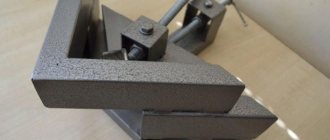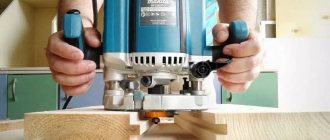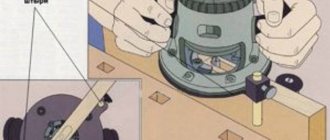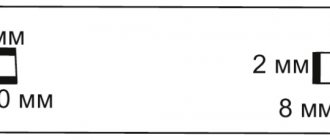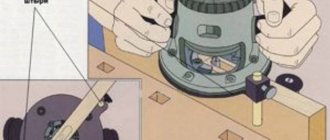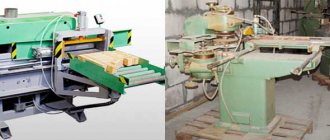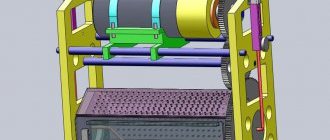Having a milling machine really simplifies the work of inserting hinges, forming complex holes, recesses, wood carving, etc.
But this does not mean at all that it is necessary to have professional and expensive equipment: it is enough to have a simple manual device. The only thing you need is to be able to basicly handle wood and use power tools. In addition, you need to have a desire, otherwise without this there will never be a result. Those who have no desire to work simply buy furniture or hire craftsmen to, for example, install a new door and cut locks. Any work, especially with power tools, requires certain knowledge, and especially safety precautions.
Why do you need a milling machine?
The milling device is designed for processing both wood and metal. With its help, it is possible to form recesses or holes of any configuration. This greatly simplifies tasks such as inserting hinges and inserting locks. Doing this with a chisel and an electric drill is not so easy, and it takes a lot of time.
There are stationary milling devices and portable (manual). Hand-held electric milling machines are considered universal devices, with the help of which, in the presence of attachments, it is possible to perform operations for various purposes; you just need to change the position of the part in relation to the device or vice versa.
Stationary devices are used in factories or factories where mass production of wood or metal products is established. Under such conditions, the cutting attachment is stationary, and the workpiece moves along the desired path. When using a hand tool, on the contrary, the part is fixed motionless and only then it is processed, although there are parts that require fixing a hand tool. This is provided for in the design, therefore, it is considered more universal. This is especially true when a large number of parts need to be processed, and it is not possible to use a stationary machine.
A homemade milling machine is a horizontal platform with a hole in the center, to which a hand-held device is attached from below.
There are many types of milling machines, but for use at home or for starting your own business, universal models are more suitable. As a rule, they are equipped with a set of cutters and various devices for performing various types of operations. The only thing is that if you have a manual milling cutter, simple operations can take much longer than when using a stationary machine.
Using a manual milling device it is possible to:
- Make grooves or recesses of any shape (curly, rectangular, combined).
- Drill through and non-through holes.
- Process ends and edges of any configuration.
- Cut out complex shaped parts.
- Apply drawings or patterns to the surface of parts.
- Copy parts if necessary.
Copying parts is one of the functions of any electric milling machine.
The presence of such functions makes it possible to simplify the production of the same type of furniture or the production of identical parts not related to furniture production. This is one of the main advantages of this tool. As a rule, to produce parts of the same type, it is necessary to install copying machines, which are designed to perform only one operation, which is not always profitable, especially in small enterprises.
Inlay
Cutting thin, flush inlays requires shallow cuts and precision, making a router the ideal tool for the job. Inlaying requires shallow digging into the wood to seat the pieces flush with the surface. You can do the job with other routers, but an edge router is best suited for this task. Its small size and much lighter weight are an advantage over other models, as they provide better accuracy when inserting inlay elements.
Based on materials from rockler.com
Getting started and caring for the tool
To understand how this device works, you should familiarize yourself with its main parts and their purpose.
Composition and purpose of main components
A manual milling device consists of a metal body and a motor, which is located in the same body. A shaft protrudes from the housing, onto which various collets are placed, serving as adapters. They allow you to install cutters of various sizes. The cutter is inserted directly into the collet, which is secured with a special bolt or button, which is provided on some models.
The main elements of a manual milling device and their purpose.
The design of the milling device includes a metal platform, which has a rigid connection to the body. It is attached to the body by means of two rods. On the outside, the plate has a smooth coating that ensures smooth movement during operation.
The manual milling device has some characteristics that can be adjusted:
- Due to the handle and scale for adjusting the milling depth. Adjustment is carried out in 1/10 mm increments.
- By adjusting the rotation speed of the cutter.
At the initial stages, when mastering the tool, it is better to try to work at low or medium speeds. Although you should always remember that the higher the speed, the better the work. Especially if this concerns critical, visible areas that cannot be masked.
In addition to these levers, there is also a button to turn the product on and off, as well as a lock button. These elements are considered basic, ensuring high-quality and safe performance of work. There is also a parallel stop, which contributes to ease of use. It can be rigidly fixed or with the ability to adjust the shift of the working area away from the center.
Caring for a hand-held milling device
Usually, a factory product ends up in the hands of a person tested and lubricated, so no additional measures should be taken. Only during its operation you need to monitor its cleanliness and serviceability. At the same time, it should be regularly cleaned of dust and the lubricant should be changed, if so written in the passport. Lubrication is especially necessary for moving parts. As an option, you can use aerosol lubricants, but you can also get by with regular ones, such as Litol. The use of thick lubricants is not recommended, as chips and dust stick to them. If aerosol lubricants are used, then this factor can be eliminated.
The sole, the smooth part of the body, also requires lubrication. Regular lubrication will ensure smooth movement.
Despite this, the purchased item should definitely be checked for quality of assembly and presence of lubricant.
Unfortunately, not all manufacturers, especially domestic ones, care about build quality. There are cases when, after the very first hours of operation, screws or screws are unscrewed from a product because they were not tightened properly.
Rotation speed adjustment
The operation of any tool is associated with certain conditions related, first of all, to the nature of the material being processed. It can be plywood, composite material or regular wood. Depending on this, the rotation speed on the electrical appliance is set. As a rule, the technical data sheet always indicates the operating parameters of the device, depending on the technical characteristics and characteristics of the surfaces being processed, as well as the cutters used.
Indicators of processing speeds when using various cutters.
Fixing the cutter
The first thing the work begins with is installing and securing the cutter. At the same time, you should adhere to the basic rule - all work is performed with the cord plug removed from the socket.
The cutter is installed according to certain marks, and if they are missing, then to a depth of no less than * the length of the cutter itself. How to install a cutter on a specific model can be found in the instructions, which must be included in the technical documents for the device. The fact is that each model may have its own design features and it is not possible to talk about this in the article.
Installing the cutter on the device before starting work.
There are both simple and more “advanced” models, as they say. Some models have a shaft rotation lock button, which makes installing the cutter easier. Some, especially expensive models, are equipped with ratchets. So it won’t be possible to specifically describe the process of installing the cutter, and it doesn’t make sense, since everyone who is familiar with the operation of such devices will figure it out in a moment.
Milling depth adjustment
Each model has its own maximum milling depth. At the same time, it is not always the maximum depth that is required, but a certain depth that is set before work. Even if maximum depth is required, in order not to overload the device, the milling process is divided into several stages, changing the milling depth in steps. For adjustment, special stops are provided - limiters. Structurally, they are made in the form of a disk located under the bar, on which stops of various lengths are fixed. The number of such legs can be from three to seven, and this does not mean that the more there are, the better. It is better if it is possible to adjust each of the legs, even if their number is minimal. To secure this stop in the optimal position, you should use a lock in the form of a flag.
The process for adjusting the milling depth is as follows:
- The tool should be placed on a flat surface, after which the clamps are released and the cutter is pressed with your hand so that it rests against the surface.
- By unscrewing the lock, the turret stop is released.
Choosing a turret stop leg. - The leg that corresponds to the milling depth is selected, after which the disk with the legs is installed in the correct position.
- In this case, the screw is not fixed, and the bar is held with a finger. After this, the movable pointer moves so that its readings coincide with the zero mark.
- Then the rod rises to the mark that corresponds to the milling depth and only then the turret stop lock is lowered (photo below).
Thus, the workpiece is milled to a given depth.
On high-quality, expensive models there is a wheel for precise adjustment of the milling depth.
Using this wheel, you can more accurately set the depth without disturbing the previous setting.
This wheel (green in the photo above) allows you to adjust the depth within small limits.
Devices and how to use them
Two simple devices are used together with the router - a rip fence (guide) and a compass. They are included with most models.
Rip fence
This is a bar that is mounted on two plates or round rods that are inserted into the lugs on the router's support platform and secured with wing screws. The plank moves along one side of the workpiece, the cutter processes the other side.
The bar prevents the router from moving to one side, outward. In this case, the milling cutter can “dive” deep into the workpiece if the cutter is without a limit bearing at the bottom.
The parallel stop (guide) is used only when processing workpieces with straight sides (edged board or block). There are restrictions for use on the width of the workpiece:
- there is not enough plate length for a workpiece that is too wide;
- on narrow workpieces that do not extend beyond the edge of the platform, the bar does not reach the workpiece.
Therefore it is used quite rarely.
Compass
It is inserted into the platform eyes in the same way as the parallel fence, but has not two, but one platinum (pin). At the end there is a centering sharpened cone (needle). Used for surface sampling of circles and semicircles.
Sometimes a through cut is made with a milling cutter, that is, the circle is cut out completely in several passes, and then the circle is processed with an edge or profile cutter. The method is suitable for making door and other arches, applying ornaments with semicircular and round elements.
When the length of the plate (pin) is not enough to work with large diameters, make homemade compasses of the required length.
Sometimes the router is used in a stationary position, mounted in a table with the cutter facing up. But the table cannot be considered a fixture; it is a separate structure.
Milling cutters for hand milling tools
A milling cutter is a cutting tool that can have an intricately shaped cutting edge. As a rule, all cutters are designed for rotational movements and therefore have a cylindrical shape. The shank of the cutter, which is clamped in the collet, has the same shape. Some cutters are equipped with a thrust roller, so that the distance between the cutting surface and the material being processed remains constant.
Milling cutters are made only from high-quality metals and their alloys. If you need to process soft wood, then HSS cutters will do, and if you need to process hard wood, then it is better to use cutters made of harder HM alloys.
Each cutter has its own technical characteristics, which provide it with high-quality and long-lasting performance. The main indicator is the maximum speed of its rotation, which should never be overestimated, otherwise its breakdown is inevitable. If the cutter is dull, you should not try to sharpen it yourself. Sharpening of cutters is carried out using special, expensive equipment. After all, you need not only to sharpen the cutter, but also to maintain its shape, which is no less important. Therefore, if for some reason the cutter becomes dull, it will be cheaper to buy a new one.
The most popular cutters
There are cutters that are used in work more often than others. For example:
- Edge cutters. With their help, the end surfaces of wooden blanks are cultivated. In addition to the curved edge, they can be used to form spikes or grooves to connect parts. Such cutters may have a bearing at the end that rests on the part, setting the processing distance.
Some types of edge cutters. - Groove cutters. These are cutters for forming grooves of various shapes. They, in turn, are:
- Spiral (a) - used to form technical grooves, such as tongue/groove.
- Fillet (b, d) - used for finishing surfaces in the form of grooves of various shapes and depths. They can be rounded, V-shaped or curly.
- Dovetail (c, d) - used to create a specially shaped groove intended for hidden or open connection of wooden parts.
- Shaped (d) - intended for decorating wooden surfaces. As a rule, they help create free-form grooves.
Groove molds are designed to create recesses in any location on the workpiece.
There are cutters that are simple, monolithic, made from a single piece of metal, and there are typesetters. Set cutters consist of a shank, which serves as the basis for a set of cutting elements. By selecting cutting planes and installing them on the shank, using washers of various thicknesses, you can form an arbitrary relief on the surface of the workpiece.
A set cutter is a set of cutting surfaces and washers that allows you to assemble a cutter of the desired shape.
In fact, there are a lot of cutters and this is only a small fraction of what is produced. All cutters differ in the diameter of the shank, the diameter of the cutting surfaces, their height, the location of the knives, etc. As for manual milling equipment, it is enough to have a set of five of the most common cutters. If necessary, you can purchase them at any time.
Rules for working with hand milling tools
Working with power tools requires special rules, especially when there are rapidly rotating elements. In addition, as a result of work, chips are formed that fly in all directions. Despite the fact that most models are equipped with a protective shield, this does not fully protect against the flow of chips. Therefore, it is better to work with such a tool wearing safety glasses.
The photo shows a model where a vacuum cleaner is connected to remove chips.
General requirements
If you follow the basic requirements for safe work with an electric hand router, the end result will please you with the quality of work and a safe outcome. These are the conditions:
- You should always use only sharp tools. How sharp a cutter is can be judged by the quality of the surface treatment. In addition, in such conditions the engine begins to get very hot.
- The material that needs to be processed must be securely fastened, otherwise normal operation will not occur.
The use of clamps for fastening the workpiece. - It is not recommended to remove the entire surface in one pass, as this increases the load on the cutter and the tool (motor). This entails a decrease in processing speed, and therefore a decrease in quality. Therefore, if the depth is decent, then it is better to remove the excess several times.
- The cutter is replaced only when the unit is de-energized, and turning it off with a switch alone is not enough. It is necessary to remove the plug from the socket.
The requirements are not very complex and quite feasible, but ignoring them means exposing yourself to danger. And one more thing, no less important, is the ability to hold a milling tool in your hands and feel how it works. If serious vibrations are felt, then you need to stop and analyze the reasons. It is possible that the cutter is dull or there is a knot. Sometimes it is necessary to correctly set the rotation speed of the cutter. Here you can experiment: either add speed or reduce it.
Safety precautions
Woodworking machines are the most dangerous type of equipment. A hand router is no exception. Working with it requires caution, accuracy and knowledge of safety regulations:
- Clothing should be sufficiently tight, without hanging ends, ties or other interfering elements;
- Wood dust is dangerous for the respiratory system and is a strong allergen. It is recommended to use a respirator, at least a regular “petal” one;
- Flying chips may get into your eyes. Most routers have a protective shield, but it would be a good idea to use glasses;
- It is necessary to hold the machine firmly in your hands. During operation, it vibrates and tends to turn in the direction opposite to the rotation of the shaft. You should not be distracted and let go of the running router;
- Recess the cutter shank into the collet by at least 20 mm and securely tighten the nut with a wrench;
- Before work, check the condition of the bearings on the edge cutters. They should not creak, wobble, or jam. If flaws are noticed, the roller must be replaced;
- First you need to start the milling cutter and wait until the working rotation speed is reached, and only after that insert the cutter into the material. If it is necessary to stop work, first remove the cutter from the material, then stop the machine;
- Always ensure that there are no nails or screws in the wood, and that there are no foreign objects or tools in the rotation zone of the cutter.
More detailed safety rules can be found in the user manual. Milling cutters from different manufacturers may have their own specific safety rules that you need to be aware of and follow during operation.
Edge processing: using templates
It is better to process the edges of a wooden board using a surface planer. If this is not possible, then you can use a hand router, although this will take some time. These works are carried out both without a template and with a template. If there are no skills or very few of them, then it is better to use a template. For processing edges, straight edge cutters are used, both with one bearing at the end of the cutting part and with a bearing at the beginning (see photo).
Edge cutters.
You can use an already processed board or other flat object as a template. Moreover, the length of the template must be greater than the length of the workpiece, both at the beginning and at the end of the workpiece being processed. This will avoid unevenness at the beginning of the edge and at the end. The most important thing here is that the template or object acting as a template has a smooth and even surface. In addition, its thickness should not be greater than the gap located between the bearing and the cutting part.
The width of the part is less than the length of the cutting part
Moreover, the longer the cutting part, the more difficult it is to work with the tool, since more effort is required. In this regard, it is better to start working with cutters that have an average length of the cutting part. The operating principle for edge processing is as follows:
- The template is attached so that it is at the desired height and has a flat horizontal surface.
- The template is firmly mounted to a table or other surface.
- The cutter with the roller is installed so that the roller moves along the template, and the cutter (cutting part) moves along the workpiece. To do this, perform all the necessary manipulations with the template, workpiece and tool.
- The cutter is installed in the working position and clamped.
- After this, the tool turns on and moves along the template. In this case, you should decide on the speed of movement, which is determined by the depth of processing.
- The milling unit can be either pushed or pulled, depending on what is convenient for you.
After the first pass, you should stop and evaluate the quality of the work. If necessary, another pass can be made by adjusting the position of the tool. If the quality is satisfactory, then the clamps are removed, freeing the workpiece.
Using this approach, it is possible to remove a quarter along the edge or in some of its parts. This is done by setting the cutting edge so that it extends to the required depth into the part.
Quarter shot on a furniture façade.
If you replace the cutter with a shaped one and move the guide, as well as use a stop, you can actually apply a longitudinal pattern to the part (pictured below).
Applying a longitudinal figured pattern to the workpiece.
If you use a similar milling technique (with a template), you can easily master the technique of working with wood in general. After some time, you can abandon the templates, since their installation takes a lot of useful time.
How to make a straight edge without a template: you can’t do this without experience.
The width of the part is greater than the length of the cutting part
Quite often, the thickness of the workpiece is greater than the length of the cutting part of the cutter. In this case proceed as follows:
- After the first pass, the template is removed and another pass is made. In this case, the template will be the already processed part. To do this, the bearing is guided along the machined surface. If the cutting part was again missing, then another pass will have to be made.
- For final processing, you should take a cutter with a bearing at the end, and the workpiece should be turned upside down, after which it is secured with clamps. As a result, the bearing will move along the machined surface. This approach makes it possible to process thick parts.
The bearing is guided along the machined surface, and the cutting edge processes the rest of the workpiece.
In order to master the work of a hand milling tool, you will need a lot of rough blanks, which you don’t mind throwing away later. No one succeeded the first time. To achieve anything, you need to train hard.
Achieving Various Shaped Edges
If a figured edge is required, which is most likely necessary, then first pay attention to the condition of this edge. If it is uneven, then you will have to level it and only then begin to form a curved edge by selecting the appropriate cutter.
Rounded edge.
It is necessary to prepare the surface so that the cutter does not copy the curvature along which the roller will move. In this case, a sequence of actions is needed, otherwise a positive result will not work.
If you need to process a frankly curved surface, then you can’t do without a template. It can be cut from plywood, about 10 mm thick, by first applying a pattern and cutting out the template with a jigsaw. The edge of the template must be brought to perfection using a hand router.
Drawing on plywood.
To mill a curved edge, first use a router without a template, carrying out the so-called rough processing. After this, the template is fixed and the workpiece is processed finally. If there are places where you need to remove a lot of material with a milling cutter, then these places can be cut out with a jigsaw.
Working with a hand router using a template
Work on milling wood blanks for tongue-and-groove joints
Another purpose of a manual milling machine is to process the edges of wooden products to connect them to each other. A groove is cut out on one workpiece, and the second is milled for the corresponding tenon.
Parts for the tongue-and-groove connection
The work takes place in the following sequence:
- The first block of wood will go under the tenon. The length of the protruding part is set off from the edge, and markings are applied. It is recommended to measure up to 40 mm for furniture legs, and 60-70 mm for doors.
- A shallow cut is made along the marked line with a hacksaw.
- Install the wood cutter in the collet of the hand-held machine. For such work, tongue-and-groove attachments are used on the router, two in one set: one for the tenon, the second for the notch.
- The workpiece is placed on the workbench. It is worth fastening another wooden beam of similar thickness perpendicular to it - it will serve as a support for the sole of the router.
- On the milling machine, the immersion depth of the cutting attachment is set. This indicator is set taking into account the fact that after turning the workpiece over and the second pass with the cutter, the result should be a tenon of the same thickness as the width of the groove. After setting the depth, the limiter is set.
- The router is turned on and tenon sampling begins. The required depth is not achieved immediately, but gradually, with an increase of 3 mm after each time.
- After the nozzle has completely passed to the specified depth, the machine is turned off, the workpiece is turned over and a sample is made on the other side using a similar method.
- Since the groove in the center of the wooden piece will have rounded edges, the tenon should be given the same shape. A well-sharpened knife or sharpening machine is suitable for this. If the groove and tenon run along the entire length or width of the wooden parts, there is no need to round the corners - the notch will be rectangular.
Tenon and notch roundings
- The groove is extracted using a groove cutting attachment according to the standard procedure already mentioned.
One of the options for a tongue-and-groove connection is the so-called. dovetail. A special groove attachment known as a dovetail is installed on a manual machine. An additional metal template with slots specifically for this type of recess is also required. To ensure that the cutting head fits into the template slots without displacement, a copy sleeve is installed on the wood router. The selection of the tenon and groove is done as standard.
Dovetail pattern
